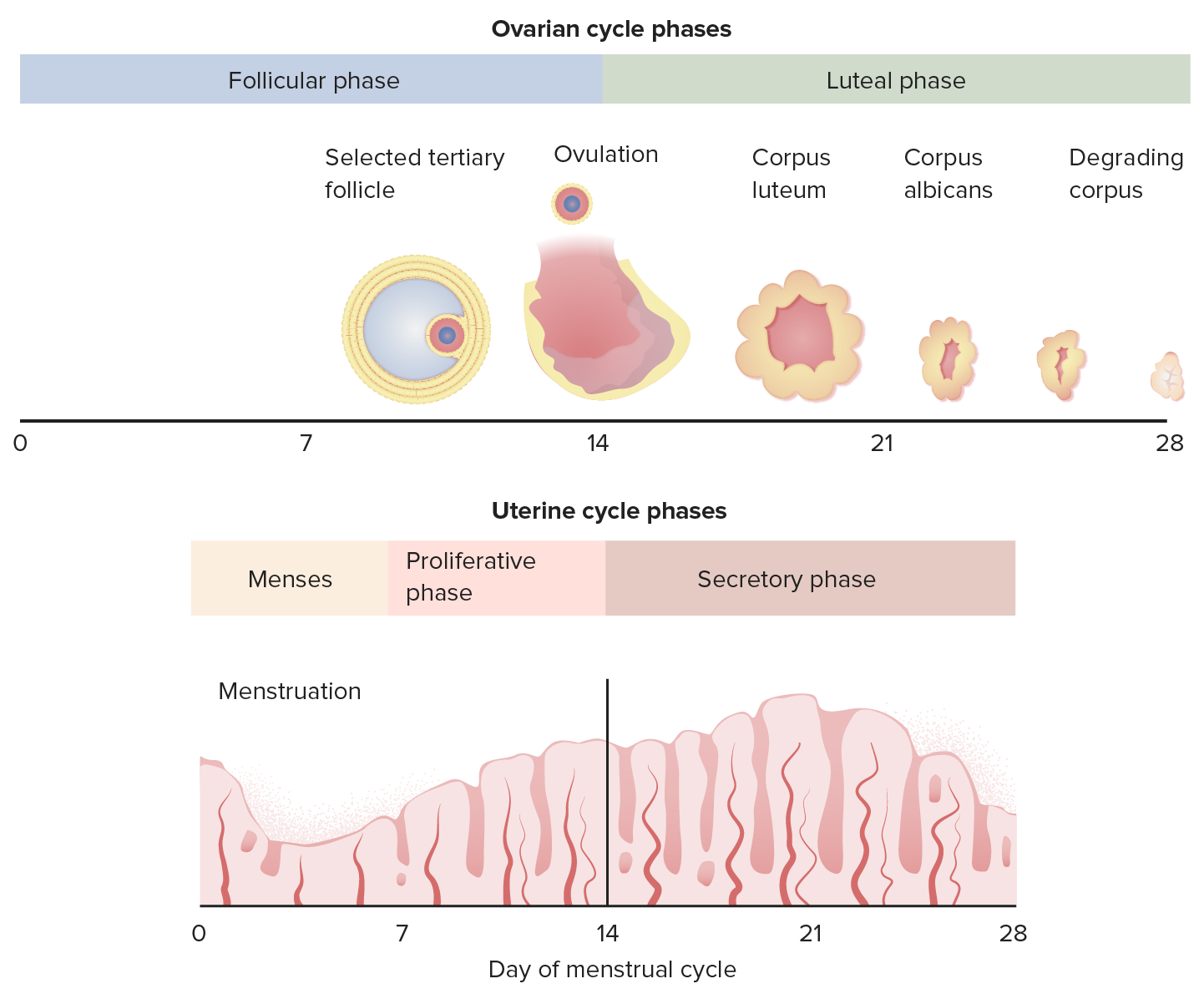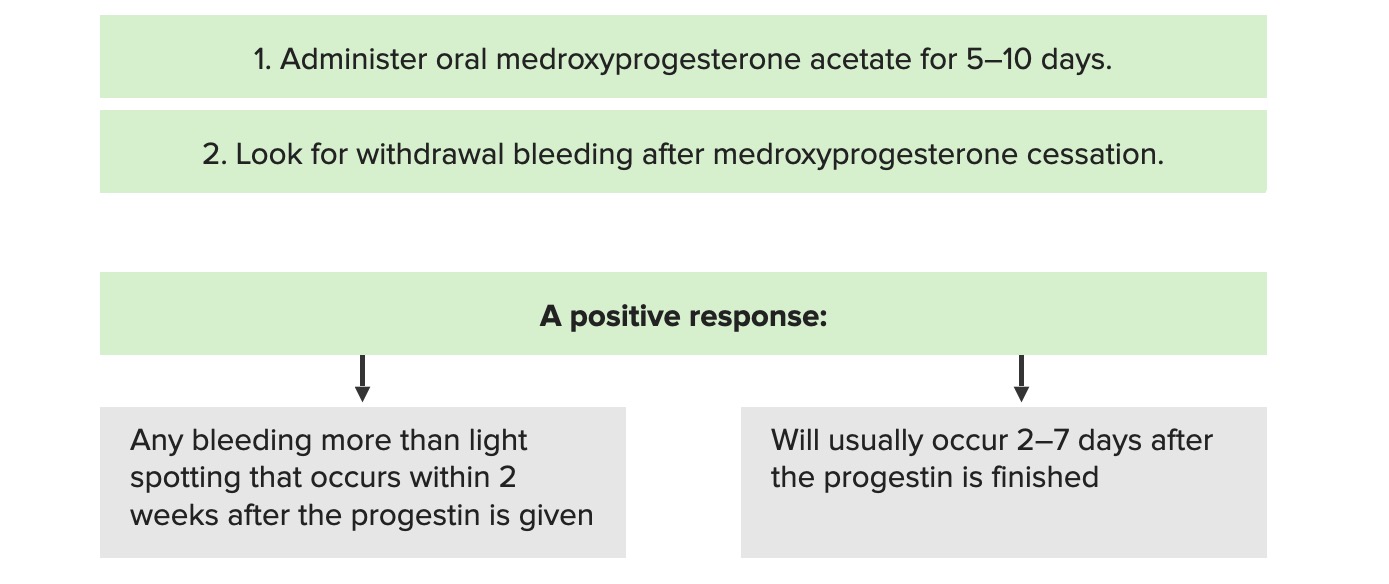Playlist
Show Playlist
Hide Playlist
Secondary Amenorrhea (Gynecology)
-
Slides Primary and Secondary Amenorrhea.pdf
-
Download Lecture Overview
00:01 Let's now talk about secondary amenorrhea. 00:03 You've had a period once but now it's gone. 00:07 That's secondary amenorrhea as supposed to primary amenorrhea, which means you never had a menstrual cycle. 00:13 Secondary amenorrhea is defined as no period for 3 cycle lengths or for 3-6 months. 00:19 That's atypical, something has gone wrong and now it's our job to find out what. 00:25 Let's now list the common causes of secondary amenorrhea. 00:30 When you have a low or normal FSH, it can be due to weight loss, so if you've lost weight in a very quick time your FSH might be quite low. 00:40 If you have an eating disorder such as anorexia or perhaps bolemia, your FSH is low. 00:46 You can have non-specific hypothalamic amenorrhea, for some reason your hypothalamus just stops firing and your anterior pituitary does not release gonadotropins. 00:57 A very common cause is chronic anovulation including PCOS. 01:01 For more information about PCOS there's a lectures about that. 01:05 You can have it with hypothyroidism, so that's when your thyroid is not functioning as it should be. 01:11 You can also see a normal or low FSH with Cushing's Syndrome. 01:16 A pituitary tumor or an empty sella or Sheehan syndrome can also cause a low or normal FSH. 01:24 Let's talk a little bit about Sheehan Syndrome. 01:27 Sheehan Syndrome is often tested on a USMLE. 01:31 It usually occurs after a postpartum hemorrhage. 01:35 Postpartum hemorrhage still occur as worldwide and is a number one cause of maternal death. 01:40 In the US, it's less so but with Sheehan Syndrome you get pituitary apoplexy because of Pituitary loses blood flow during a postpartum hemorrhage. 01:50 These women typically cannot lactate postpartum and they also lose their axillary hair and they never have return to menses. 01:57 So watch out for this on your exam. 01:59 Let's not talk about high FSH as a cause of secondary amenorrhea. 02:04 This can occur with 46, XX individuals who have primary ovarian insufficiency or you can have an abnormal karyotype that leads to early cessation of menstrual cycles. 02:15 This is the case with Turner Syndrome patients. 02:18 The majority of cases with Turner Syndrome presents with primary amenorrhea. 02:25 Secondary amenorrhea appears in less than 10% of patients usually in those who carry up partial deletion of the X chromosome or have sex chromosome mosaicism. 02:37 You can also have a high prolactin that causes secondary amenorrhea. 02:42 There is another lecture set that you can download to learn more information. 02:46 There are also anatomic causes of secondary amenorrhea. 02:50 This is the case in Asherman Syndrome, you typically see Asherman Syndrome after pregnancy where some type of dilation and curettage has occurred. 02:59 This can occur as a result of a postpartum hemorrhage or post-abortal. 03:04 These adhesions, because the uterus to actually have adhesions between the two walls and can obstruct any menstrual flow. 03:11 You can also find secondary amenorrhea in hyperandrogenic states. 03:17 This happens with an ovarian tumor, non-classical congenital adrenal hyperplasia and also undiagnosed hyperandrogenism. 03:26 There are a lot more causes but we're going to review just the large ones here, functional hypothalamic amenorrhea is actually the most common cause of secondary amenorrhea. 03:39 You can also have hyperandrogenism and polycystic ovarian syndrome. 03:44 Hyperprolactinemia is third, premature menopause or ovarian insufficiency comes in fourth. 03:51 Asherman's Syndrome is last and then you can have other uncommon causes of secondary amenorrhea. 03:58 But I wouldn’t worry so much about those in your USMLE. Try to remember the above. 04:03 Now, we'll go over what we should do when a patient presents with secondary amenorrhea. 04:09 First, you need to complete a thorough history and physical examination. 04:14 Second, don’t forget to rule out pregnancy as this is a common cause in the reproductive age. 04:20 Third, we need to get an FSH, usually in conjunction with an estradiol, on the third day of the menstrual cycle and a prolactin. 04:28 A prolactin needs to be taken in the AM and fasting. 04:32 If the FSH is actually equivalent or not higher or not low, you should suspect an anatomic defect such as Mullerian, a genesis or dsygenesis. 04:44 If the prolactin is high you should do a radiographic evaluation for prolactinoma. 04:51 Unless, there is an obvious cause as to why the prolactin is high. 04:54 Again, there is another lecture that you can listen to that talks about prolactin. 04:59 If the FSH is elevated, this can indicate ovarian failure or ovarian insufficiency. 05:06 This is seen in gonadal dysgenesis. 05:08 If the FSH is low or equivocal, this can mean chronic anovulation as you see with PCOS and functional hypothalamic amenorrhea.
About the Lecture
The lecture Secondary Amenorrhea (Gynecology) by Lynae Brayboy, MD is from the course Abnormal Menstruation. It contains the following chapters:
- Secondary Amenorrhea and its Causes
- Secondary Amenorrhea: Diagnosis
Included Quiz Questions
Which of the following best describes secondary amenorrhea?
- A woman who had her menses in the past but has not had menses for 6 months.
- A woman who had her menses in the past but has not had menses for 2 months.
- A woman who had her menses in the past but has not had menses for 1 month.
- A woman who never had her menses in the past.
- A woman who had her menses in the past but has not had menses for 2 cycles.
Which of the following is the etiology of Sheehan's syndrome?
- Pituitary apoplexy
- Underdeveloped pituitary
- Pituitary adenoma
- Pituitary agenesis
- Pituitary cyst
A 26-year-old woman comes with a history of inability to lactate and no menses for 9 months. She has 2 children in the past. Her record shows that she was transfused 8 units of compatible blood due to postpartum hemorrhage. What is the probable diagnosis?
- Sheehan syndrome
- Empty sella syndrome
- Mullerian dysgenesis
- Transfusion-related complication
- Asherman syndrome
Which of the following is the most common cause of pathologic secondary amenorrhea?
- Functional hypothalamic amenorrhea
- Sheehan syndrome
- Polycystic ovarian syndrome
- Premature menopause
- High prolactin levels
A 30-year-old woman complains that she has missed her periods for 3 months. She recently lost her job and has difficulty taking care of 2 children by herself. Her examination doesn't reveal any positive findings except for breast tenderness. What should be the next step in management?
- Perform serum pregnancy test (hCG).
- Perform vaginal ultrasound to rule out Asherman syndrome.
- Perform serum prolactin levels.
- Start counseling since the probable cause of amenorrhea is stress-induced.
- Perform FSH and LH hormone testing on serum.
What describes hormonal changes in secondary amenorrhea? Select all that apply.
- Chronic anovulation - FSH decreased or equivocal
- Chronic anovulation - FSH increased
- Ovarian failure - FSH decreased
- Prolactinoma - FSH decreased or normal
- Ovarian failure - FSH increased
Customer reviews
5,0 of 5 stars
| 5 Stars |
|
1 |
| 4 Stars |
|
0 |
| 3 Stars |
|
0 |
| 2 Stars |
|
0 |
| 1 Star |
|
0 |
All are well explained Useful for all doctors in thair practice Thank you





